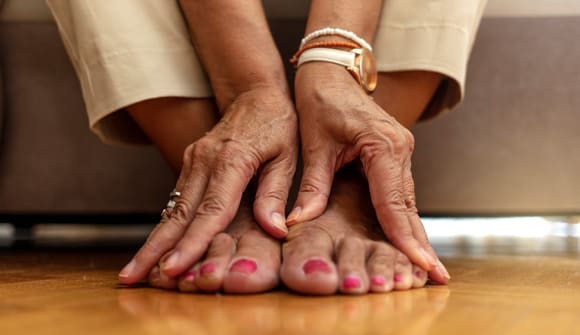Why feet fail
Common causes of foot pain.
Article Date:

Imagine an inventor trying to create the world’s first foot. He may find himself overwhelmed because the foot has to do so many things.
It goes from rigid to flexible with each step. It holds up to movement and standing still. It supports weight, navigates all types of terrain, and cycles through millions of steps over the course of a lifetime.
Feet see a lot of use and abuse, and when they fail, it often happens all at once, said Mark Gould, MD, an orthopedic foot and ankle surgeon with Baptist Health and Jacksonville Orthopaedic Institute. Here are some of the most common problems, and what to do about them.
Pain by location
The part of the foot in which you feel discomfort may provide clues as to the cause.
Arch or heel
Dr. Gould said that if the first few steps out of bed in the morning create a stabbing pain in the arch or heal, plantar fasciitis is the likely culprit.
“The pain is usually worse in the morning and gets better as you walk,” he said. “It happens when the sole of the foot has been strained repeatedly, usually from too much running or walking.”
With plantar fasciitis, the cord of tissues that connects the heel bone to the toes tears and becomes inflamed. For relief, try icing, stretching and taking over-the-counter anti-inflammatory medications. A doctor can help by offering a night splint or a cortisone injection.
Above the heel
Throbbing pain along the back of the leg is usually caused by Achilles tendinitis, according to Dr. Gould.
“It occurs behind your ankle and can make it hard to run or walk,” he said. “This is another overuse injury and it often happens when you step up your activity or intensity level.”
The condition occurs when there’s inflammation of the Achilles tendon, which connects your heel to your calf muscles. For relief, try stretching, icing and taking anti-inflammatory meds. A doctor can also provide a flexible orthotic heel lift that takes stress off the tendon.
In the joints
If the joints in the foot ache while bearing weight or moving, it could be a sign of arthritis.
“It can be in the toes, foot or ankle,” he said. “Unfortunately, it comes with age and isn't something you can prevent.”
Arthritis causes the cartilage that cushions the bones at the joints to break down. The joint can feel grating and stiff. If the pain advances to the point where your movement is limited, a cane or walker may help.
Fractures
Breaks are more likely to happen when a person’s bone density is low because weaker bones break more easily under stress.
After age 40, bone mass naturally starts to decline.
Another source of fractures comes from overdoing high-impact activities, said Dr. Gould.
“You want to get an aerobic workout to maintain your cardiovascular health. But if you’re trying a boot camp or CrossFit program and you’re not ready for it, you can injure yourself,” he said. “It’s important to realize that as you get older, your body doesn’t recover from exercise as quickly as it used to.”
Preventing foot pain
A great way to avoid injuries and pain is by stretching your legs before doing an activity, Dr. Gould recommended. Another way is to always wear a good set of shoes. You should:
- Buy shoes that match the shape of your foot. Feet can be oblique, round or square, and so can a shoe. They should feel comfortable immediately.
- Make sure your shoes provide proper arch support.
- Throw out old shoes. Worn-down shoes offer less protection.
When should you call a doctor?
When pain strikes, at what point should you ditch the home care and see a professional? Dr. Gould said to schedule an office visit if you have:
- Pain that is persistent that doesn't improve after several weeks.
- Numbness, tingling or burning pain on the bottom of your foot.
- Persistent swelling that doesn't improve after five days of home treatment.
Are you experiencing foot pain that’s preventing you from doing your normal activities? Baptist Health and Jacksonville Orthopaedic Institute can help. Schedule an appointment online at the location nearest you.



